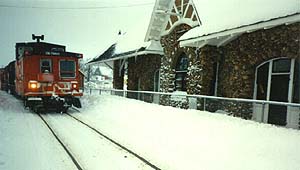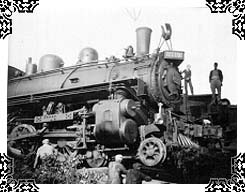








By 1947, the change from steam to diesel powered locomotives on Prince Edward Island was well underway. Instead of the steam which had previously driven the motor, the new diesel electric locomotive featured a gas engine, which powered an electric generator. The apparent advantages of the diesel engine over its steam-powered forerunner were overwhelming, and the change was made in the name of progress and cost-cutting.
 Diesel
engines were more economical to operate, with higher fuel
efficiency, lower maintenance, and fewer breakdowns.
Unlike steam engines, the new gas-powered model did not
need to be serviced or changed every 200 miles. They were
also more powerful than steam engines and allowed one
engineer to handle extra freight cars, making for a more
streamlined and efficient rail system. It also permitted
the railway companies to eliminate some jobs, as the
position of fireman-- the crew member who stoked the fires
to produce steam-- was made obsolete by the new engines.
With all of these factors working in its favor, the
replacement of steam by diesel was quick and total. In
1950, 91 percent of the trains in Canada were steam
powered; within a decade, that number had dropped to just
over 1 percent.
Diesel
engines were more economical to operate, with higher fuel
efficiency, lower maintenance, and fewer breakdowns.
Unlike steam engines, the new gas-powered model did not
need to be serviced or changed every 200 miles. They were
also more powerful than steam engines and allowed one
engineer to handle extra freight cars, making for a more
streamlined and efficient rail system. It also permitted
the railway companies to eliminate some jobs, as the
position of fireman-- the crew member who stoked the fires
to produce steam-- was made obsolete by the new engines.
With all of these factors working in its favor, the
replacement of steam by diesel was quick and total. In
1950, 91 percent of the trains in Canada were steam
powered; within a decade, that number had dropped to just
over 1 percent.
The last of the steam engines
was retired on P.E.I. in 1950. Partly because it had a
small, self-contained rail system, the Island had been at
the forefront of the move from steam to diesel, first
serving as a testing ground  for
the new gas-powered engines and then becoming the first
province in Canada to complete the switch-over. At first,
Island railwaymen appreciated how the diesel engines
eliminated many of the back-breaking tasks that their job
had involved, such as the never-ending chore of shoveling
coal. But while the steam engines may have required
constant service, engineers were most often able to patch
up their own engines and make it back to the station for
repairs. Diesel engines, on the other hand, were far more
complex. When breakdowns occurred in a diesel engine,
they were usually electrical in nature, and another
diesel engine would have to be called to tow it back to
the repair yard.
for
the new gas-powered engines and then becoming the first
province in Canada to complete the switch-over. At first,
Island railwaymen appreciated how the diesel engines
eliminated many of the back-breaking tasks that their job
had involved, such as the never-ending chore of shoveling
coal. But while the steam engines may have required
constant service, engineers were most often able to patch
up their own engines and make it back to the station for
repairs. Diesel engines, on the other hand, were far more
complex. When breakdowns occurred in a diesel engine,
they were usually electrical in nature, and another
diesel engine would have to be called to tow it back to
the repair yard.
Increasingly, the train crews seemed indifferent toward-- or even critical of-- the diesel, a far cry from the pride that they remembered having for their steam engines. In the steam engine, there would always be a tool kit in the cab, ensuring that whatever possible stop-gap measures were taken to get the train to the station. When one Island engineer-- newly placed on a diesel engine-- was asked what type of tool kit he carried, he disgustedly pulled out a piece of scrap paper with the name and telephone number of a diesel foreman from Moncton. Also, some railwaymen found that the modernization of trains had left the trains without personality. There was a definite romance surrounding the steam engine, which roared into the station like a dragon before coming to a stop with its trademark hiss. The comparatively silent, electrically-powered diesel engines may have brought efficiency to the railway, but deprived it of a good measure of its mystique. Railroaders looked on the steam engine as an animate, living and breathing object-- always referring to the engine as "she"-- and these fundamental changes to their way of life did not come easily.
 However, any debate about the advantages
of steam or diesel soon was immaterial, as it became
increasingly clear that the entire railway was in real
danger of disappearing from P.E.I. It became rarer and
rarer sight to see even a modern diesel engine rolling
down the Island tracks. As soon as everyone owned an
automobile, they no longer wanted to cope with railway
schedules, and on October 25, 1969, the trains picked up
Island passengers for the last time. Those who wanted to
catch a train had to be bussed to Moncton. Also, farmers
began relying on trucking instead of trains to get their
harvests to market, and the Trans-Canada Highway eclipsed
the CNR as the main shipping route. The closing of
stations, which began in 1962, progressed until there
were only stations in major centres like Summerside and
Charlottetown, and even these only had a corporal's guard
on staff.
However, any debate about the advantages
of steam or diesel soon was immaterial, as it became
increasingly clear that the entire railway was in real
danger of disappearing from P.E.I. It became rarer and
rarer sight to see even a modern diesel engine rolling
down the Island tracks. As soon as everyone owned an
automobile, they no longer wanted to cope with railway
schedules, and on October 25, 1969, the trains picked up
Island passengers for the last time. Those who wanted to
catch a train had to be bussed to Moncton. Also, farmers
began relying on trucking instead of trains to get their
harvests to market, and the Trans-Canada Highway eclipsed
the CNR as the main shipping route. The closing of
stations, which began in 1962, progressed until there
were only stations in major centres like Summerside and
Charlottetown, and even these only had a corporal's guard
on staff.
 The last train into Kensington passed
through on December 22, 1989. In an interesting footnote
to history, the train was traveling in reverse on its way
through town, backing up all the way to New Annan to pick
up a tank car. In many ways, this backwards journey out
of town was an appropriate symbol for how the railway
disappeared from the Island, in a slow, drawn-out retreat
from its former status as a vital transportation system.
The last train left aboard the ferry on December 31,
1989, over 114 years after the first scheduled train
traveled over the P.E.I. Railway. Its long whistle, part of the fabric
of Island life, will never be heard again.
The last train into Kensington passed
through on December 22, 1989. In an interesting footnote
to history, the train was traveling in reverse on its way
through town, backing up all the way to New Annan to pick
up a tank car. In many ways, this backwards journey out
of town was an appropriate symbol for how the railway
disappeared from the Island, in a slow, drawn-out retreat
from its former status as a vital transportation system.
The last train left aboard the ferry on December 31,
1989, over 114 years after the first scheduled train
traveled over the P.E.I. Railway. Its long whistle, part of the fabric
of Island life, will never be heard again.
